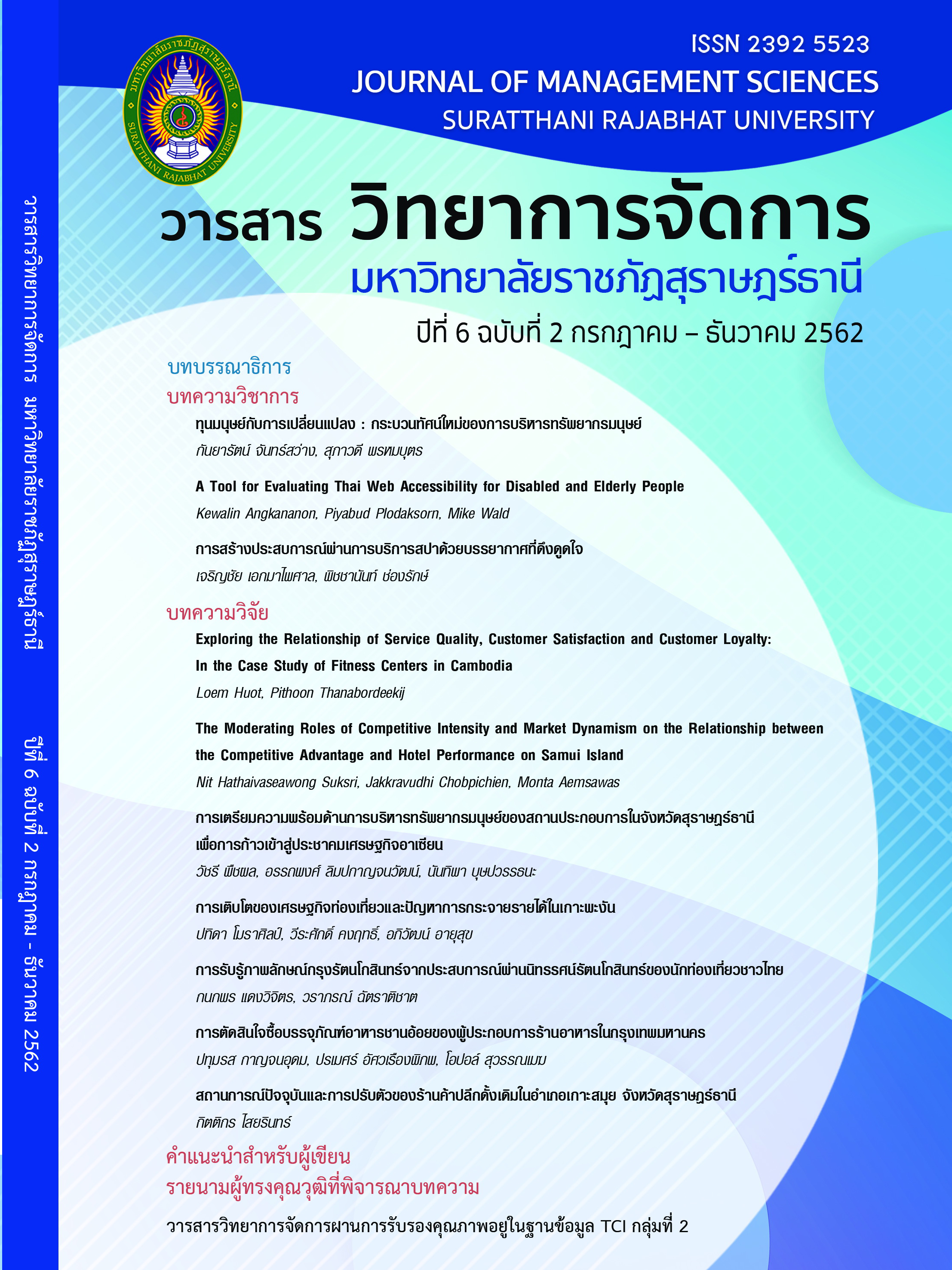Exploring the Relationship of Service Quality, Customer Satisfaction and Customer Loyalty: In the Case Study of Fitness Centers in Cambodia
Main Article Content
Abstract
Cambodian Fitness market space nowadays is getting more crowded than ever. Therefore, loyalty to fitness members is very important for business owners. However, overall studies about dimensions and relationships to build customer loyalty in fitness centers is insufficient. The purpose of this paper is to: (1) investigate how perceptions of service quality influence members’ satisfaction of fitness-clubs in Cambodia; (2) determine key drivers of loyalty outcome behaviors which attribute from the loyal customer in fitness centers. The methodology involved the compilation of a literature review and conduction of a quantitative approach. The instrument used in this study was adopted from Service Quality Assessment Scale (SQAS) scale and Customer Satisfaction and Loyalty Outcome scale. Survey data were collected from 424 members who have been using the clubs more than 3 months from the four fitness centers. The finding results showed four dimensions out of six service quality perception namely; Staff, Physical facilities, Workout Facilities, and Childcare, that capture the customer attention to be satisfied to the club and they possibly contributed favorable loyalty outcomes to club such as refer club’s identification to their peers, club’s exclusive consideration to service usage, word of mouth, strength of preferences to buy other product lines that brand has, and share of wallet. The result of this study would enable management to identify service quality dimensions influencing their members’ satisfaction which led to membership loyalty.
Article Details
References
Babakus E, Boller GW. (1992). An empirical assessment of the SERVQUAL scale. Journal of Business Research, 24: 253 - 268.
Bourdeau, B. L. (2005). A New Examination of Service Loyalty: Identification of the Antecedents and Outcomes of an Attitudinal Loyalty Framework. Electronic Theses, Treatises and Dissertations.
Brady, M. K. & Cronin, J. J. (2001). Some new thoughts on conceptualizing perceived service quality: a hierarchical approach. Journal of Marketing, 65(3): 34 - 49.
Butcher, Ken, Beverley Sparkes, & Frances O’Callaghan (2001), “Evaluative and relational influence on service loyalty,” International Journal of Service Industry Management, 12(4), 310 - 27.
Carman JM (1990). Consumer perceptions of service quality: an assessment of the SERVQUAL dimensions. Journal of Retailing, 66(1): 33 - 55.
Chang, K., & Chelladurai, P. (2003). System-based quality dimensions in fitness services: Development of the scale of quality. eService Industries Journal, 23(5), 65 - 83.
Chelladurai, P., Scott, F. L. and Haywood-Farmer, J. (1987), “Dimensions of fitness services: development of a model”, Journal of Sport Management, Vol. 1, pp. 159 - 72.
Dick, A. S. and Basu, K. (1994), “Customer loyalty: Toward an integrated conceptual framework,” Journal of the Academy of Marketing Science, 22(2), 99 - 113.
Harvey, J. (1998). Service quality: A tutorial. Journal of Operations Management, 16(5), 583 - 597.
Hussey MK. (1999). Using the concept of loss: an alternative SERVQUAL measure. The Service Industries Journal, 19(4): 89 - 101.
International Health, Racquet & Sportclub Association (The IHRSA). (2006). Asia Pacific Market Report: The Size and Scope of the Health Club Industry. Boston: The IHRSA.
Karddes, Frank R., Gurumurthy Kalyanaram, Murali Chandrashekaran, and Ronald J. Dornorff (1993), “Brand retrieval, consideration set composition, consumer choice, and the pioneering advantage,” Journal of Consumer Research, 62 - 75.
Kotler P, Armstrong G. (2003). Marketing. International Edition, Prentice Hall.
Lagrosen, S. (2001), “Strengthening the weakest link of TQM – from customer focus to customer understanding”, The TQM-Magazine, Vol. 13 No. 5, pp. 348 - 54.
Lam, E.T.C., Zhang, J. J. and Jensen, B. E. (2005), “Service quality assessment scale (SQAS): an instrument for evaluating service quality of health-fitness clubs”, Measurement in Physical Education and Exercise Science, Vol. 9 No. 2, pp. 79 - 111.
Murray, D., & Howat, G. (2002). The relationships among service quality, value, satisfaction, and future intentions of customers at an Australian Sports and Leisure Center. Sport Management Review, 5, 25 - 43.
Parasuraman, A., Zeithamal, V. A., & Berry, L. L. (1985). A conceptual model of service quality and its implications for future research. The Journal of Marketing, 41 - 50.
Papadimitriou, D. A. and Karteroliotis, K. (2000), “The service quality expectations in private sport and fitness centers: a reexamination of the factor structure”, Sport Marketing Quarterly, Vol. 9 No. 3, pp. 157 - 164.
Phnompenh Post . (2013, May 29). Gym membership gets a lift. (H. Kimsay, Producer) Retrieved August 30, 2017, from https://www.phnompenhpost.com/business/gym-membership-gets-lift.
Reynolds, Kristy B. and Mark Arnold (2000), “Customer loyalty to the salesperson and the store: Examining relationship customers in an upscale retail context,” Journal of Personal Selling and Sales Management, 20(2), 89 - 98.
Rust R. T, Oliver R. L (1994). Service quality: insights and managerial implications from the frontier. In Service Quality: New directions in theory and practice, Roland T. Rust and Richard L. Oliver, Eds. Thousand Oaks, CA: Sage Publications: 1 - 19.
Walsh, K. (2013), “Global health club industry proves resilient”, IHRSA global report, available at: https://download.ihrsa.org/press/2013_IHRSA_Global_Report_Feature.pdf (accessed 28 August 2017).
Zeithaml, V. (1988). Consumer perceptions on price, quality, and value: a mean-end model and synthesis of evidence. The Journal of Marketing, 2 - 22.
Zeithaml, V., Parasuraman, A. & Berry, L. L. (1990). Delivering Quality Service, The Free Press, New York, NY.
Zeithaml, V. A., Berry, L. L., & Parasuraman, A. (1996). The behavioral consequences of service quality. Journal of Marketing, 60(4), 31 - 46.


